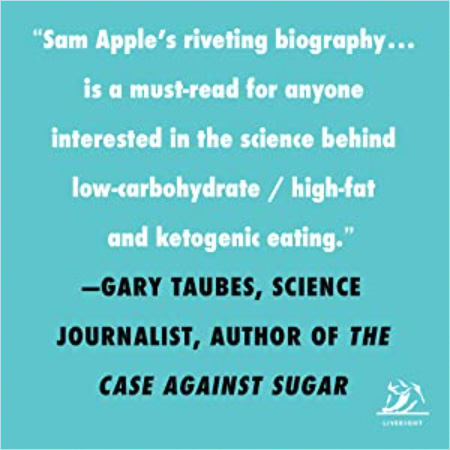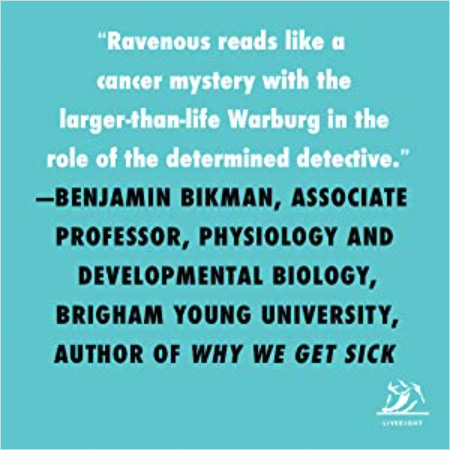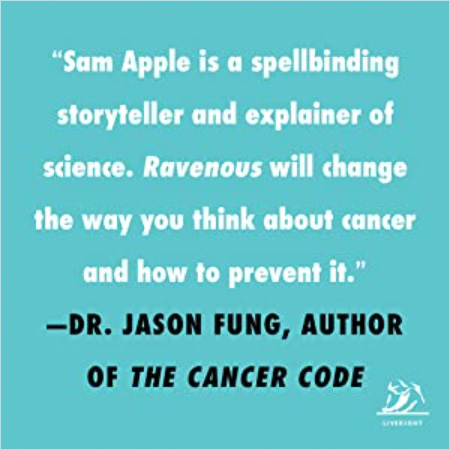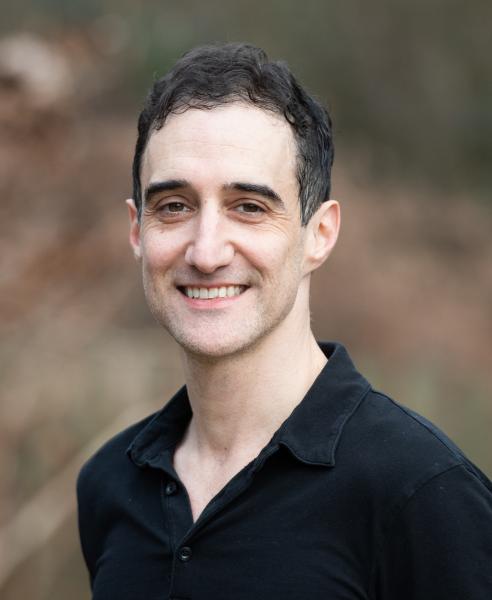Otto Warburg, The Nazis, and the Search for the Cancer-Diet Connection

While working on my new book, Ravenous, I wanted to understand the surprisingly strong relationship between obesity and cancer. While obesity is commonly assumed to be a cause of cancer, I was particularly intrigued by the hypothesis that elevated insulin is driving both obesity and cancer. In this excerpt from Ravenous, I review how insulin was discovered and how our understanding of insulin changed our understanding of human health.
-Sam Apple
P.S. I'm especially happy to be able to share an excerpt on the blog of Roxana and Joy, who are doing so much important work in raising awareness of these issues.
How Breakthroughs in Insulin Research Changed Our Understanding of Obesity, Diabetes, and Cancer
Like cancer, diabetes is an ancient disease that had been relatively rare prior to the nineteenth century. Aretaeus of Cappadocia, the Greek physician who gave the disease its name, noted that it was "not very common to man." Galen, who called diabetes "diarrhea of the urine," reported only having seen two cases. By the nineteenth century, diabetes was far more common than it had been in the ancient world, but still vastly less common than it is today. From 1824 to 1898, Massachusetts General Hospital admitted almost 50,000 patients for a variety of different ailments. Only 172 patients were identified as having diabetes. Data from other hospitals during the same period reveal the same striking absence of hospitalizations for diabetes.
And then something changed. In 1875, only 3.4 of every 100,000 Berlin residents died of diabetes. By 1890, that rate had tripled. Fifteen years later, it had tripled again. Berlin was not alone. Other Western cities saw similar increases. In 1897, the Journal of the American Medical Association stated that "it appears that the general frequency of this disease is steadily increasing." Over the next 20 years, the diabetes death rate in American cities would increase by as much as 400 percent.
That the rise in diabetes deaths occurred alongside the rise in cancer deaths didn't go unnoticed. While Ernst Freund's 1885 monograph showing elevated glucose in the blood of cancer patients was the first concrete evidence of a connection between diabetes and cancer, others would soon follow. In his influential 1908 book, The Natural History of Cancer, the British surgeon W. Roger Williams noted a recent uptick in reports linking diabetes to malignant tumors. Most who had "specially studied this subject," Williams wrote, "maintain that the diabetic state" favors "the development of malignant disease."
The association wasn't so strong as to be indisputable. Williams made clear that his own cancer patients were rarely diabetic and that there remained "a lack of conclusive evidence" for a connection between the two diseases. That uncertainty would linger for years to come. In his 1937 book on rising cancer rates in industrialized societies, Frederick Hoffman wrote that diabetes had begun to increase "at about the same rate as cancer." But Hoffman, too, felt the evidence wasn't yet definitive.
The doubts about the cancer-diabetes connection were well founded. The most that could be said was that both diseases had become more common over the same general time frame. And even to be confident about that claim, one first had to demonstrate that the increase in diabetes was a real phenomenon. That was never easy to do. Reports of the dramatic increase in diabetes were often met with the same skepticism as reports of the dramatic increase in cancer. There were more cases of diabetes, the argument went, because it had become easier to diagnose and people were living to older ages. Elliott Joslin, the most famous diabetes doctor in American history, was among the skeptics. In 1917, he mockingly wrote that the "frequency of diabetes in a community may be the index of the intelligence of its physicians."
The counterarguments, in turn, were essentially the same counter-arguments made with regard to the increase in cancer: physicians had known the symptoms of diabetes for thousands of years, and it was not difficult to detect the disease at its most advanced stages. Hospitals had been using tests to detect glucose in a patient's urine since the 1850s, decades before the rise in diabetes became pronounced. And old age was not a late nineteenth-century innovation; most of the gains in average life expectancy could be attributed to fewer deaths in childhood.
Though it did little to settle the debate, another interesting parallel between diabetes and cancer was sometimes noted: diabetes was not becoming more common everywhere. Among populations following their traditional diets, the disease remained extremely rare. In many cases, the absence of diabetes was discovered by the very same traveling doctors who had observed the absence of cancer in indigenous populations. After traveling to the Arctic in 1905, the surgeon Nicholas Senn declared that cancer was a "disease of civilization," yet he also noted that the "Eskimos" were "almost exempt" from diabetes. Sir Robert McCarrison's most surprising claim after several years among the Hunza was that the locals never got cancer. But he also pointed out that they never got other diseases, including diabetes.
Such populations, it soon became clear, were not free of diabetes because of their genes or shorter life spans. As soon as they adopted Western lifestyles - often it happened first among the wealthier classes - diabetes would arise, sometimes so rapidly that medical experts of the time were left stunned. The same pattern could be seen in every part of the world, from Thailand and Tunisia to Native American reservations in the western United States.
The most compelling evidence that Western living habits could cause diabetes emerged from studies of migrant populations. In 1966, the physician and researcher George Campbell wrote of a "veritable explosion of diabetes" among the poor Indian laborers he studied in South Africa. In some of the villages, approximately one-third of the middle-aged Indian men had diabetes. This was striking in itself, but all the more striking because, across India, only one in every 100 citizens had the disease.
The Israeli diabetes specialist Aharon Cohen recorded a similar explosion of diabetes among Yemenite Jews in Israel. When Cohen carried out his studies in the 1950s, he had the advantage of looking at two waves of immigrants. The Yemenites who had immigrated to Palestine in the early 1930s were as likely to have diabetes as anyone else in Israel. But among the 5,000 Yemenites who came to Israel in 1949, Cohen found only three cases of diabetes. Living in Israel for a mere 15 or 20 years made a Yemenite immigrant's chances of developing diabetes almost 50 times greater.
Scientific researchers today no longer question whether diabetes became far more common starting in the second half of the nineteenth century. Rates have only continued to increase. Since 1960, the diabetes rate in the United States has increased by 800 percent, and half of American adults are now estimated to have either diabetes or prediabetes. Nor do researchers still question whether diabetes is associated with cancer. As a 2010 "consensus report" published by the American Diabetes Association and the American Cancer Society put it, "Epidemiologic evidence suggests that people with diabetes are at significantly higher risk for many forms of cancer." People with diabetes who are diagnosed with cancer are also less likely to survive than those without diabetes.
Making sense of the relationship between diabetes and cancer was not easy because diabetes itself was not well understood. By the late nineteenth century, it was clear that diabetes came in two primary forms, known today as type 1 and type 2. Type 1 diabetes tends to arise in children and is typically more severe. Type 2 diabetes, the more common form of the disease, afflicts adults, especially the overweight. Despite these important differences, both forms of diabetes have the same effect: blood coursing with glucose that our cells are unable to eat.
The first critical breakthrough in understanding the role of insulin in diabetes took place in April 1889. Two German researchers fell into a debate about whether secretions from the pancreas were needed to digest butter. To find out, they removed the pancreas from a dog and noticed something far more interesting: the dog wouldn't stop urinating on the laboratory floor. Without a pancreas, it had immediately developed diabetes.
From that point on, it was understood that the pancreas released a mysterious substance that gave cells permission to eat glucose. The substance became known as "the internal secretion," and researchers across the world set out in search of it. Some three decades later, Frederick Banting, a young Canadian surgeon, read a scientific article about the pancreas and had a new idea for how to capture the "internal secretion." The idea turned out to be entirely wrong, but Banting's efforts nevertheless succeeded. The "internal secretion" became known as "insulin," and it immediately revolutionized diabetes care. Another "dreaded" disease, the New York Times reported, had been "overcome by science."
As insulin treatments were used more often in the following years, researchers found a new way to distinguish between the two types of diabetes. Some people with diabetes were insulin dependent (type 1 diabetics), while others (type 2 diabetics) could often survive by changing their diets or taking other medications. And yet, even after this new distinction had been made, the two conditions were still said to be essentially the same. If people with type 2 diabetes had elevated glucose, the thinking went, they couldn't possibly have enough insulin in their blood.
It all made perfect sense, and yet, it was only a guess. No one could say exactly how much insulin was in the blood of people with diabetes - or without diabetes, for that matter. Insulin is a tiny protein and there was no good way to measure it in our blood. As one newspaper article put it, trying to measure the amount of insulin in a person's blood was like trying to measure a teaspoon of one substance in "a lake 62 miles long, 62 miles wide and 30 feet deep."
The problem seemed insurmountable, at least until the 1950s, when Rosalyn Yalow took it on. Yalow, a physicist, had a history of breezing past seemingly insurmountable obstacles. After graduating from Hunter College in 1941, she found that there were few, if any, opportunities for a woman who wanted to become a physicist, particularly a Jewish woman. Yalow took a job as a secretary at Columbia University in the hope of being able to enroll in graduate courses. She was finally admitted to the physics program at the University of Illinois only because the war had left positions available. Even then, Yalow first had to agree to a stipulation: the physics department would not help her find a job after she earned her degree. It was an outrage, but an opportunity nonetheless. Before leaving New York for Illinois, Yalow took the time to rip up her stenography books.
By 1947, Yalow was working at the Veterans Administration hospital in the Bronx, studying medical uses of radioactive carbon in a room that had once been a janitor's closet. She had hired a physician, Solomon Berson, to work with her, and in the late 1950s, they arrived at a breakthrough that relied on the same principle Warburg had used to identify his respiratory ferment. Warburg saw that light and carbon monoxide compete for his ferment. Yalow and Berson took insulin from someone's blood and let it compete for antibodies with a radioactive insulin - which, unlike normal insulin, they were able to measure. The amount of radioactive insulin that would end up unbound to antibodies could then be used to calculate the amount of insulin in the sample. The test became known as a radioimmunoassay, and it gradually revolutionized modern medicine.
Yalow won the Nobel Prize in 1977, but researchers were initially slow to appreciate the full implications of the new test. In the early 1960s, Yalow and Berson had the field largely to themselves, and they explored a series of critical questions about insulin and disease that had previously been unanswerable. Among their many findings, one in particular stood out: type 2 diabetes had been completely misunderstood.
Type 1 diabetes is a disease in which glucose rises to dangerously high levels in the blood because the pancreas loses the ability to make insulin. In most cases, Yalow and Berson discovered, type 2 diabetes wasn't like type 1 diabetes at all. It was almost the opposite condition. The blood of type 2 patients had more insulin than normal (in addition to more glucose), rather than less. The problem of type 2 diabetes, Yalow and Berson saw, was not that the pancreas could no longer produce insulin but that cells were no longer listening to insulin's instructions to eat. Such cells, in the scientific terminology, are "insulin resistant." The pancreas responds to the resistance by pumping out more and more insulin.
Insulin resistance does not set in uniformly. Cells of the muscle and liver might be slow to heed insulin's call even as the fat tissue continues to listen all too well. And because insulin tells fat cells not only to take up energy but also to store it, the extra insulin in the blood needed to overcome insulin resistance will make us put on weight. (Yalow and Berson were the first to see that obese individuals commonly had elevated insulin levels.) Over the years, the effects of the elevated insulin will accumulate, and more and more energy will be trapped inside of our fat cells. In the words of Harvard endocrinologist and metabolism researcher David S. Ludwig, "Insulin is like a Miracle-Gro for fat cells."
The extent to which elevated insulin is responsible for obesity is still debated, but that insulin tells our fat tissue to take up and hold on to nutrients was clear to diabetes doctors from the moment they began to inject the hormone into their patients. Before insulin therapy, people with type 1 diabetes remained stick thin no matter how much they ate. Once they began to inject insulin into their blood, the change was dramatic. The before and after photos look as if someone had blown new life into a deflated balloon animal. Frederick Allen, one of the first American physicians to prescribe insulin, noticed that the gaunt faces of his patients would begin to fill out in a matter of days, sometimes a matter of hours. "The patients seem to tend readily to become obese," Allen wrote.
The fattening effect of insulin was hard to miss, and it became still more obvious in the second half of the twentieth century, when type 2 diabetics also began to rely on insulin to keep their blood sugar under control. The more insulin they would use, the more weight they would typically gain.
Insulin's role in fat storage is easy to appreciate in the context of an evolutionary past in which the timing of one's next meal was never certain. Insulin in the blood is a sign that glucose is being served and that the body shouldn't waste its own energy reserves. Burning stored fat when glucose is available makes no more sense than a village tapping into emergency grain reserves amid a plentiful harvest. When insulin levels are low, by contrast, it means that glucose hasn't been ingested for an extended period. The energy stored inside of fat cells will now flow back out to feed cells throughout the body.
Insulin is supposed to rise as we eat and then fall in the hours after a meal. If insulin levels remain elevated throughout the day, a condition known as hyperinsulinemia, our fat tissue will hold on to its stores of energy, and we will grow hungry even if we have eaten relatively recently. It is as if a village has all the grain reserves it needs but cannot manage to unlock the silo. "A sort of anarchy exists," wrote the influential Viennese endocrinologist Julius Bauer in 1929. The fat tissue now "lives for itself."
Bauer, yet another brilliant Viennese Jew who would flee the Nazis in 1938, noticed something else as well: when it is gobbling up nutrients and growing with no regard for the rest of our cells, our fat tissue is no longer behaving like a tissue in a body of cooperative cells. The expanding fat tissue is now acting, Bauer wrote, like a "malignant tumor."
Written by Sam Apple
Published: December 18th, 2021



